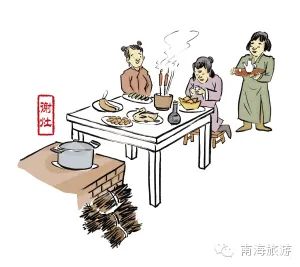January 26 was the Little New Year (Chinese: Xiaonian) in southern China, which marks that Spring Festival is getting closer.

Speaking of Little New Year, what comes in mind can be offering sacrifices to the Kitchen God, eating Zaotang, or “hearth candy”, a kind of candy made of barley sugar, often takes the shape of a stick or a ball, and many other customs. It is worth pointing out that different locations celebrate it on different dates.

Differences in dates
Little New Year is the day when people “sweep the dust away”, or do house-cleaning, and offer sacrifices to the Kitchen God. The date of this Festival is different from place to place since different places have their own customs. While people in northern China celebrates it on the twenty-third day of the twelfth lunar month, people in southern China does it on the twenty-fourth day.

Wang Juan, an expert of folklore says that back in ancient days, although the calendar was revised every year, the exact date on which people celebrated the festival differs based on regional needs and understandings. Date of celebration has varied as time went by, which is a perfect proof to China’s cultural variety.
Wang believes that certain dates are needed to mark certain events since Chinese New Year lasts rather long. Celebrating Little New Year is a way for the Chinese to say farewell to the past and welcome to the future.
Culture Insider: Little New Year
One important folk activity of celebrating Little New year is to offer sacrifices to the Kitchen God.
According to Wang, offering sacrifices to the Kitchen God, one of the five most valued deities for Chinese households, is an important thing in ancient times. As time went by, this custom has become so ubiquitous that it has been practiced by both dynasty and common people.

Wang also says that in the old days, dynasty celebrated the festival on the twenty-third day of the twelfth lunar month, common people did it on the twenty-fourth, and fishmen twenty-fifth. Therefore, different places celebrated Little New Year on different dates based on local traditions.
It is believed that the Kitchen God is the one who manages kitchen fire and family members’ diet throughout the year. On Little New Year, he is expected to report to the Jade Emperor, the ruler of heaven, who will decide whether to punish or reward the family according to the deitys words.

People are expected to offer sacrifices to the Kitchen God, and help him ascend to heaven on Little New Year.
Life is not always full of sweetness and happiness. Quarrels and argues take place from time to time, but the Chinese do not want the Kitchen God to report these unharmonious events. As a result, Zaotang, an exceptionally sticky and sweet candy, is offered to the deity because people hope that by doing so, bad words can be locked in, and only sweet words are spoken by the Kitchen God.
Wang explains that the celebration of offering sacrifices to the Kitchen God was first practiced in Xia Dynasty, and had not been celebrated as a formal tradition until Han Dynasty.
The start of a busy year
It is generally accepted that the Little New Year is the start of a busy year. From this very day to Chinese New Year’s Eve, people are busy preparing for the New Year. One of their focuses is to “sweep the dust away”, or house-cleaning. Every family undertakes a thorough house cleaning by washing all kinds of vessels, quilts, curtains and many other things in preparation for the New Year.
Besides, adults and children take baths and haircuts to refresh themselves. People believed that this is also a way to say farewell to the past and welcome to the future.
Cutting papers and pasting up paper-cuts are interesting events during the whole preparation. These paper-cuts usually have patterns such as "Magpies and plum blossoms" (Chinese: Xi Que Deng Mei), "Swallows thorough a willow" (Chinese: Yan Chuan Tao Liu), and “Lotus and fish” (Chinese: Nian Nian You Yu) that embodies people’s wishes for an auspicious New Year. Folk stories are also popular elements for paper-cuts.
"Sense of participating" is the key to folk activities during Little New Year, implicating that people are busy preparing for the coming Spring Festival, and are looking forward to family reunion.
Author | Natalie (Intern)
Revisor | Jersey